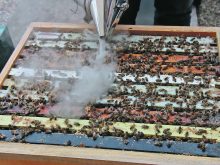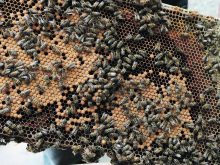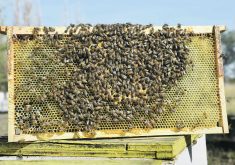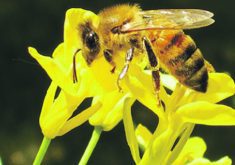Despite reports of high losses of honeybees across the Prairies, it is too early to tell what the full reckoning will be this spring, warned a scientist.
“I want to stress that the losses will increase from here on in — we’re not done,” said Shelley Hoover, a research associate in the Department of Biological Sciences at the University of Lethbridge.
Estimates of average losses have ranged from 40 to 45 percent in Alberta and Manitoba to about 30 percent in Saskatchewan, executive director Ron Scarlett of the Canadian Honey Council said during an earlier interview.
Read Also

Drones now used to assess wildlife crop damage in Saskatchewan
Wildlife damage in Saskatchewan crops is now assessed by drones and artificial intelligence.
Hoover said the spread of parasitic varroa mites in honeybee colonies was a factor in the losses. However, the situation is also being influenced by prolonged cold weather this spring, she added.
It includes a recent major snowstorm in Manitoba that saw accumulations as high as 82 centimetres.
Parts of Alberta were also hit by a large snowstorm this month, with Calgary receiving 22 centimetres of snow on April 19, which is more than the city experienced during the entire month of March. Another 13 cm fell in the region on April 22.
“So, the longer the winter is, the more stressful (for bees),” Hoover told a recent webinar on bees and society hosted by the Southern Alberta Council on Public Affairs.
She called the province a powerhouse for beekeeping in Canada. During some years, Alberta has contained more colonies than the next three largest provinces combined, she said.
However, some beekeepers have reported losses this spring as high as 90 percent, vice-president Lorne Prins of the Alberta Beekeepers Commission said during an earlier interview. The province has not seen an increase in total hives in about a decade, which “just goes to show it’s becoming increasingly challenging to keep bees alive,” he said.
High levels of varroa mites largely occurred due to an early spring in 2021, which was followed by summer heat waves that lasted into the fall, said Scarlett. Some beekeepers in the British Columbia Interior placed Styrofoam insulation on top of their colonies to protect them from the high temperatures, said Hoover.
People as a society need to lower their carbon footprint to try to reduce climate change, she said. “All of those things that benefit all of our natural world will benefit bees.”
Besides commercial beekeeping operations using introduced European honeybees, Alberta also has managed species of leafcutter bees and bumblebees, she said.
The province also contains more than 320 native bee species representing more than 40 percent of the known total in Canada, she added.
“And especially in southern Alberta, we’re in a bit of a bee biodiversity hotspot where we have almost 100 species that … are found only in southern Alberta.”
The interactions between such bees and the plants they depend on in an era of climate change are not well understood, said Hoover. However, one of the consequences can be a mismatch in timing between the growth of plants and when bees start their lifecycle, she said.
“So, we’ll see changes in nectar production, pollen production, number of flowers, size of flowers, and so that starts to get into nutritional impacts on bees. It starts to get into which flowers are attractive to bees, so there’s a whole host of things that can happen and it’s very complex.”
Other factors affecting bee health include agricultural chemicals such as pesticides, herbicides and fungicides, she said.
“And we know that if you combine products, sometimes that can overwhelm the detoxification system of bees and then all of a sudden that product becomes toxic when it isn’t on its own.”
Although honeybees are mostly used in Alberta to produce honey, they also help boost agricultural yields through pollination of crops such as seed canola in the southern part of the province, said Hoover. Studies have linked inadequate pollination to declines in global agricultural yields of 20 to 50 percent, she said.
















